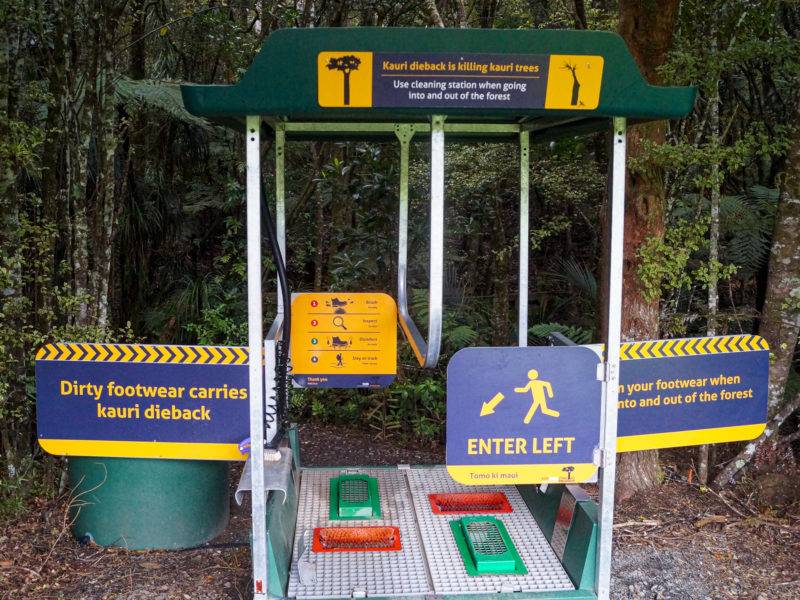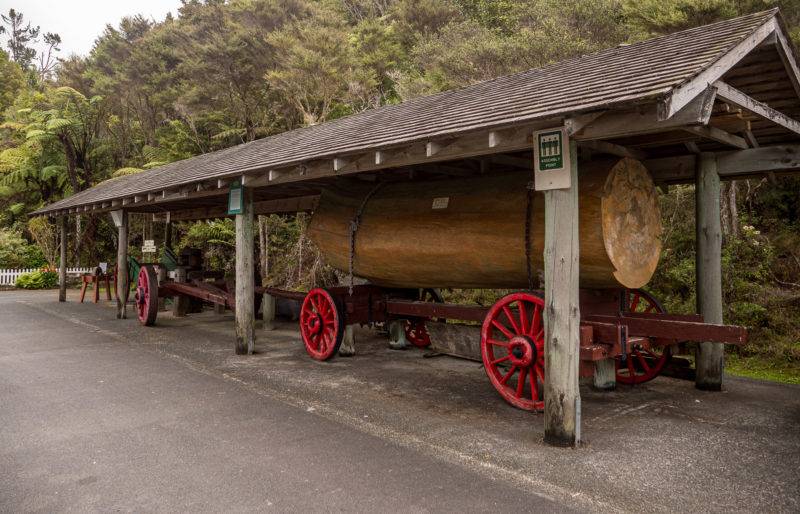Discover the most beautiful Kauri forests in New Zealand
New Zealand is the land of Kauri trees. In New Zealand there are still some representatives of the Kauri trees and many beautiful places where you can see these forest giants.
Besides New Zealand you can find Kauri trees in the Pacific area from Malaysia to New Zealand, and you can find them also in the Philippines, New Guinea, Melanesia or Australia.
What questions do we answer in this article?
- What is a Kauri tree
- Where else can you find Kauri trees
- What Is Kauri Dieback Disease
- What meaning do Kauris have for Maori
- What was Kauri wood used for
- What is Kauri gum
- What is Kauri gum used for
- What Kauri souvenirs are to be found
- Questions, comments or ideas
What's a Kauri tree?
A Kauri tree belongs to the araucaria family of plants. Besides the name Kauri tree, they are also called Kauri spruces or Kauri pines. The Kauri tree is evergreen and very large with a spherical crown. The largest known Kauri tree in New Zealand is Tane Mahuta, also called the god of the forest. It is located in Waipoua Forest in Northland. His exact age is unknown, but he is estimated to be 1250 to 2500 years old. It is the largest known Kauri tree. Tane Mahuta is 51,2m tall and its circumference is an impressive 13,77m which corresponds to a diameter of 4,4m. The trunk height from the ground to the base of the crown is 17.68m. Interesting with the Kaur trees is the fact that these have their first branches only in large height. At the same time the Kauri is the largest tree species native to New Zealand.
Beside Tane Mahuta there are other Kauri trees in New Zealand, which we explain in the next section.
Where else are there Kauri trees
All Kauri trees in New Zealand are located on the North Island. The largest number of Kauri trees are found in the region called Northland, i.e. above Auckland to Kaitaia.
But also on the Coromandel peninsula there are still some remaining Kauri trees, these are less touristy and therefore worth a look. We'll list the best spots for you here:
- Waipoua Forest: Let's start with the largest number of Kauri trees, these are located in the so-called Waipoua Forest. A nature reserve with huge dimensions. As there is only one bigger road (SH12) through the forest, some of the trees are well developed for tourism. So you can easily drive up to a few meters to Tane Mahuta, the largest Kauri tree. Only a few minutes’ drive away there is a second well-developed Kauri tree collection. This includes the second largest Kauri tree, Te Matua Ngahere (father of the forest) and a tree called the four sisters (The 4 Sisters). These trees can be visited with little effort in under 30 minutes. In addition, there is another Kauri tree to which you must hike a shorter hike of about 1.5 hours return, this Kauri tree is also called Yakas. Directions and info: Tane Mahuta (Google Maps/D.O.C.), Te Matua Ngahere & Four Sisters & Yakas (Google Maps/D.O.C.)
The 2nd biggest Kauri of New Zealand
- Trounson Kauri Park: In Trounson Kauri Park you can make different hikes and see Kauri trees of different sizes up close. Much less touristic but all the more impressive. Here we were in complete peace and could look at everything including the info boards in peace. Near the park there is also a simple camping site (Trounson Kauri Park Camp Site) nearby. At night you can also see a kiwi in the forest. Directions and info: Trounson Kauri Park (), Trounson Kauri Park Camp Site (Google Maps/D.O.C.)
- Manginangina Kauri Walk: The Manginangina Kauri Walk is off the main roads and can only be reached by a longer gravel road. Above Kerikeri this Kauri Walk is comfortably developed and for all to walk comfortably. Altogether you can see some Kauri trees in a super short walk (10 minutes return). If you want to see Kauri off the beaten track with little time, this is your place. Directions and information: Manginangina Kauri Walk (Google Maps/D.O.C.)
- Warkworth Kauri Park & Museum: Here in Warkworth is the first opportunity to see Kauris. Closest to Auckland is this spot. Besides a Kauri tree which you can see directly from the parking lot, there is also museum and remains of a felled Kauri to realize the dimensions. The access is comfortable over paved roads and therefore no problem for rental cars and campervans. Directions and information: Warkworth Kaur Park (Google Maps/Museum)
Kauri tree in front of the Warkworth museum
- Waiau Kauri Grove: Waiau Kauri Grove is located on the Coromandel Peninsula and can be reached by gravel road. From here there is a small walk (approx. 30 minutes return) and there are several Kauri trees to view. Here is also the only place in New Zealand where we still had the possibility to hug a Kauri tree. If you miss the Northland but would like to see a Kauri tree, this is your chance. Directions and information: (Google Maps/D.O.C.)
- Hakarimata Kauri Grove: The Hakarimata Kauri Grove is the most southern Kauri Walk we found. From the parking lot we walk up a few steps. Then the path opens and you can enjoy the view to the north. Then you come to a Kauri tree which is estimated to be over 1000 years old. If you follow the path further you will come to a Kauri tree that fell in 2009. Finally you can go a little further and come to a viewpoint that gives you a view over the forest. Directions and information: (Google Maps/D.O.C.)
What Is Kauri Dieback Disease
Kauri Dieback Disease is a dangerous and highly contagious disease for Kauri trees. In detail, the Kauri tree is attacked by a microscopically small fungus-like organism during Dieback Disease. This organism is capable of infecting kauri trees of all sizes and ages. The pathogen is called Phytophthora agathidicida (PA) and lives in the soil and attacks the Kauri roots. It damages the tissue of the roots which transport nutrients and water into the tree, so the tree starves effectively. Almost all infected Kauri trees die over time. The pathogens and bacteria are invisible, unfortunately there is now no treatment available against this disease.
What there are however are methods to prevent the spread of Kauri Dieback Disease. These are visible on hiking trails and in many places in the form of purification stations. Please use these stations at every opportunity to give future visitors this great opportunity.

Cleaning station against Kauri Dieback disease
What importance do Kauris have for the Maori
Kauris have an important meaning for the Maori. They are the symbol of Maori culture for health and the general condition of forests and people. Therefore the value of Kauri trees and Kauri forests for the Maori should not be underestimated. In the history of Maori creation there is the following story. At the beginning of the world the god Tane lived together with his siblings and parents in darkness. Tane and his siblings separated their parents, Ranginui (the Heavenly Father) and Papatuanuku (the Earth Mother), and created light and life to exist and grow. Thus began time, the world of light and the title Tane Mahuta, God of the forest and all its creatures.
Kauri is known to Maori as Te Whakaruruhau, the great protector of the forest, and refers to the many species that can hide in Kauri trees. Many large kauri trees were named and worshipped as chieftains of the forest.
Maori also associate the Kauri tree with whales (Tohora). According to Maori genealogy (Whakapapa) Kauri and Tohora are brothers. It is believed that Tane (god of the forest) gave the whale to Tanaroa (god of the sea), giving Kauri trees their unique scales for bark.
Maori elders today often combine whale stranding’s with the fights of the Kauri tree, which is susceptible to and suffers from Kauri Dieback Disease.
What was Kauri wood used for
In New Zealand the wood of the Kauri tree was formerly used to build boats and houses. Especially after the arrival of the European settlers Kauri wood was used for various purposes. Nowadays Kauri wood is mainly used for furniture. Kauri wood is easy to process and can be compared to pine wood in terms of its processing properties. Due to its structure, however, the wood is not comparable to industrially produced solid wood. Even after careful drying and correct storage, even finished Kauri wood objects or furniture can move or crack. So, every piece of Kauri wood is unique. The wood has a brown-red colour. With sanded and finished wood, the surface can shimmer depending upon the incidence of light partially gold-coloured.

Large piece of a Kauri tree after logging
What is Kauri gum
Kauri gum is the resin of the Kauri tree in New Zealand, extracted from fossil deposits or tapped from living trees. The gum from fossil deposits is also called Kauri-Copal.
The kauri gum drips from cracks in the bark of the kauri tree and hardens on contact with air. The gum lumps formed in this way reached the ground and were covered with soil and plant parts and finally fossilized. Other lumps formed in places where new branches developed or trees were damaged.
The colour of Kauri gum depends on the condition of the tree and the time it was stored in the ground. The size of the lumps found can also vary greatly. Small nuggets, known as chips, are more common in swamps. On the slopes of hills, larger lumps were found. The majority of the lumps reached a maximum size of one acorn. Rarely there are also larger lumps, the largest known finding had a total weight of about 25 kilograms.
Kauri gum resembles amber in some characteristics. However, while amber is several million years old, fossil Kauri resin is only a few thousand years old according to initial findings.
What is Kauri gum used for
The Maori used the gum of the Kauri tree for many purposes. Fresh resin was used as a kind of chewing gum. Older gum was softened by soaking and mixing with the juice of the thistle. The resin is highly flammable and served as a firelighter or was wrapped in flax used as a torch. Combustion residues mixed with animal fat were used as pigment for moko tattoos.
Kauri resin was exported to London and America in the mid-1840s. At that time, it was used as an adhesive for shipbuilding and as a fire starter. Since the resin mixes more easily with linseed oil than other resins, 70% of the varnish produced in England in the 1890s was based on Kauri resin.
A small part of the resin was also used for paint production in the late 19th century. From 1910 it was also used for the production of linoleum.
From the 1930s, the market for Kauri resin declined as synthetic alternatives emerged.
Auckland was the largest exporter of Kauri resin between 1850 and 1950.
Today, the largest Kauri resin collection is housed in the museum in Matakohe. In addition to the extraction of kauri wood, the museum also focuses on the extraction and processing of kauri resin.
What Kauri souvenirs do exist
In addition to various smaller souvenirs that contain Kauri wood, such as key rings and earrings, there are also larger objects such as tables or other furniture made of Kauri wood in so-called wood studios. These Wood Studios are distributed throughout New Zealand. Known are for example the Matakohe Kauri Museum in Northland, or the House of Wood in Hokitika.
Questions, comments or ideas
Do you still have a specific question, comment or idea about this article? Then we are looking forward to your comment here under the article. Have fun in New Zealand!
Ask us anything
We run this blog so you can have a great time in New Zealand. All the articles and videos are free for anyone.
If you want to ask an individual question about Newzealand, your working holiday or anything else around travelling New Zealand, then this is your chance.
Even it always looks like holiday, this website and the project is a fulltime business. So you can support us with any question if you'd like.
Simply click the button and ask us, in exchange for your answer you can give what you value our time.
If every visitor would support us with 1€ per year, our business would be up running for long times. Therefore we count on your support!
A big thank you from the depth of our hearts. Julian & the team of Project-Newzealand




